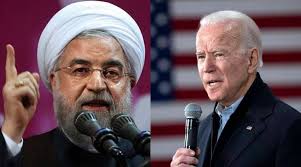Biden and the Ayatollah’s Game Plan
Amir Taheri/Asharq Al-Awsat/June 04/2021
بايدن وخطة لعبة آيات الله
أمير طاهري/الشّرق الاوسط/04 حزيران/2021
في فبراير (شباط) الماضي، عندما أطلقت إدارة بايدن الجديدة محاولتها الموعودة لإحياء «الصفقة النووية» لأوباما مع الجمهورية الإسلامية، وصفها المدافعون بأنها محاولة لمنع حرب أخرى في الشرق الأوسط. وردد ذلك صدى الشعار القديم القائل بأنه في التعامل مع النظام الخميني حتماً سيكون الخيار بين الاسترضاء والحرب الشاملة.
فشل أتباع هذا الشعار في فهم أنه في التعامل مع الملالي، فإن التهدئة هي التي تشجع على الحرب. وهكذا ما إن تم نشر فرقة الاسترضاء التابعة لبايدن حتى أنهى آية الله علي خامنئي، رجل الدين الذي يترأس النظام الخميني، ما يقرب من أربع سنوات من ضبط النفس النسبي بمحاولة إعادة إحياء العديد من النزاعات بوضع الجمر تحت ألسنة اللهب.
بدأ خامنئي باليمن، حيث سحب سفارته وبعثته العسكرية ورجال دعايته الدينية ونقلهم إلى عمان (بصفة مؤقتة)، ثم أرسل أحد جنرالاته كسفير جديد في مهمة لتحديث آلة الحوثيين الآيلة للسقوط. كانت الخطوة التالية هي تسريع إمداد وحدات «حزب الله» في لبنان بالصواريخ الجديدة، وتبع ذلك تبرعات نقدية ضخمة لـ«حماس» و«الجهاد الإسلامي» في غزة مقابل إطلاق جولة جديدة من الهجمات الصاروخية على إسرائيل. وأمر كذلك ببناء عسكري على حدود إيران مع أذربيجان وأرمينيا، للإشارة إلى نهاية الوجود المخفض للقوات الذي اضطر إلى قبوله خلال إدارة ترمب.
لكن هذا لم يكن كل شيء. فاعتقاداً منه أن الإدارة الأميركية الجديدة قد تساعده في حل مشكلة التدفق النقدي، أعاد المرشد الإيراني صياغة الميزانية الوطنية الرسمية التي أعدها الرئيس المنتهية ولايته حسن روحاني لزيادة حصته العسكرية بشكل كبير. تتضمن الميزانية المعدلة – التي تم تسريعها عبر البرلمان المبتذل مثل سكين في الزبد – زيادة بنسبة 62 في المائة في حصة «الحرس الثوري». وتضمنت الموازنة زيادة حجم «فيلق القدس» بواقع 40 في المائة، وهو المسؤول عن تصدير الثورة والحفاظ على القدر يغلي في اليمن، والعراق، وسوريا، ولبنان، وغزة. ويقدر البعض الزيادة الإجمالية للميزانية العسكرية الإيرانية منذ عام 2019 بنحو 150 في المائة.
والرسالة التي ستصل إلى الوكلاء في المنطقة وخارجها هي أن طهران تتوقع أن تكون قادرة على إنهاء التخفيضات في الميزانية التي كانت قد أجبرت على تفعيلها خلال فترة ترمب لأن الولايات المتحدة، بغمزة وإيماءة، تسمح لبعض الحلفاء، ولا سيما كوريا الجنوبية واليابان، بالإفراج عن جزء من الأموال المدينين بها لواردات النفط.
من الناحية الدينية، يرى خامنئي ورفاقه أن الصفقة المتوقعة مع بايدن هي «الفرج بعد الشدة» التي وعد بها الله المؤمنين الذين يمرون بفترة معاناة من دون أن يفقدوا إيمانهم.
يبدو أن آية الله مصمم على استخدام هذه الفرصة لتغيير التوجهات في السياسة الداخلية أيضاً. تظهر قائمة «المرشحين المعتمدين» المؤلفة من سبعة رجال والتي أطلقها للانتخابات الرئاسية المقبلة، أنه يعتزم تنصيب حكومة حرب من المتطرفين الموالين تماماً لشخصه.
هل يعني كل ذلك أن «المرشد الأعلى» يستعد للحرب؟ ليس تماماً إذا كنا نعني بالحرب صداماً كلاسيكياً واسع النطاق للقوات العسكرية في البر والجو والبحر.
يعلم خامنئي أن جيشه غير المنظم والمنقسم إلى فيالق وقيادات لا حصر لها ذات ثقافات ومصالح متضاربة، وغالباً ما يكون مثقلاً بكل ما هو قديم ومتهالك، ليس في وضع يسمح له بخوض حرب كلاسيكية ضد عدو خطير. لا أحد من كبار جنرالاته الـ13، وجميعهم في سن التقاعد ومنخرطون بعمق في أنشطتهم التجارية الخاصة، يمتلك صورة الفاتح المفترض.
يعترف خامنئي ضمنياً بذلك من خلال تكرار شعار «لا حل وسط ولا حرب».
وبقدر ما يتعلق الأمر بالدبلوماسية، فإنه سيلعب اللعبة التي بدأتها طهران منذ ما يقرب من 30 عاماً من خلال التفاوض على اتفاقيات حول «القضية النووية». قال وزير الخارجية الأميركي الجديد أنتوني بلينكن، إن الهدف هو إقناع طهران بتقليص أنشطتها النووية بحيث لا تقل عن عام واحد على الدوام لتصنيع قنبلة. فخامنئي الذي لا ينوي صنع قنبلة في هذا الوقت مستعد لأن يقدم للأميركيين الحلوى التي يتوقون إليها.
قال خامنئي الشهر الماضي: إذا قررنا تصنيع القنبلة فلن يستطيعوا (فريق بايدن) ولا من هم أكبر منهم إيقافنا. يجري تصنيف ذلك النوع من الحرب بطرق عدة مختلفة: حرب بالوكالة غير متكافئة، منخفضة الكثافة، منخفضة التكلفة. وإدراكاً منه أن فقط قلة من الإيرانيين مستعدون لخوض حرب من هذا النوع، فإنه يخوضها من خلال عملائه والمرتزقة المجندين في باكستان، وأفغانستان، والعراق، ولبنان، وغزة، واليمن. إن استخدام المرتزقة في مثل هذه الحروب له تاريخ طويل. فقد استخدم الخلفاء العباسيون العبيد المملوكين الأتراك وكان العثمانيون يمتلكون «الباشبازوق» (الجنود غير النظامين في الجيش العثماني) بينما استخدم الصفويون «القزلباش» والبشمركة الكردية. واستخدم البريطانيون في الهند الجوركا النيباليين، وقام الفرنسيون بأعمالهم الاستعمارية حينها من خلال المجندين العلويين المعروفين باسم «المساعدون».
وفقاً لأفضل التقديرات، أنفقت الجمهورية الإسلامية نحو 20 مليار دولار في حروبها المختلفة المنخفضة التكلفة منذ عام 2000، وهو مبلغ متواضع نسبياً مقارنة بالتكلفة الهائلة لحرب شاملة. وبحسب وزير الخارجية الإيراني محمد جواد ظريف، فإن النظام يحتاج إلى 60 مليار دولار على الأقل سنوياً لتغطية تكاليفه الأساسية والبقاء ليواصل حملته المستمرة منذ عقود لزعزعة الاستقرار في الشرق الأوسط على أمل تحقيق ما وصفته صحيفة «كيهان» الناطقة بلسان الخميني، بأنه «التسونامي الحتمي للثورة الإسلامية» الذي من شأنه أن يؤسس قاعدة جديدة للغزو النهائي للعالم من خلال «الإيمان والعدالة» من قبل جبهة المقاومة التي تقودها إيران.
يتحدث أنتوني بلينكن عن آماله في تحقيق «انفراج» في المحادثات «النووية» المتوقفة حالياً. وخامنئي أيضاً يريد انفراجة تستند إلى وعد بتخصيب اليورانيوم الذي لا يريده أن يقل مقابل التدفق النقدي الذي يحتاجه لإعادة تنشيط حربه الخاصة التي توقفت مؤقتا ضد الولايات المتحدة وحلفائها الإقليميين، أو في الواقع، ضد ما يُعرف غالبا باسم «النظام العالمي».
إن الخوف من حرب وهمية قد يؤدي إلى صفقة تسمح باستمرار حرب حقيقية خلف واجهة سلام وهمي.
Biden and the Ayatollah’s Game Plan
Amir Taheri/Asharq Al-Awsat/June 04/2021
Last February when the new Biden administration launched its promised bid for a revival of the Obama “nuke deal” with the Islamic Republic, apologists described it as an attempt at preventing another Middle Eastern war. This echoed the old mantra that in dealing with the Khomeinist regime, the choice is between appeasement and full-scale war.
Adepts of that mantra have failed to understand that in dealing with the mullahs it is appeasement that encourages war.
Thus, no sooner had Biden’s appeasement squad been deployed that Ayatollah Ali Khamenei, the cleric heading the Khomeinist regime, ended almost four years of relative self-restraint by trying to revive the embers of several conflicts into blazing flames.
He started with Yemen where he had withdrawn his embassy, military mission and religious propagandists, transferring them to Oman on a “temporary basis”, by sending one of his generals as the new ambassador with the mission to upgrade the Houthis ramshackle war machine. The next move was to speed up the supply of new rockets and missiles to his Hezbollah units in Lebanon. That was followed by a massive cash handout to Hamas and Islamic Jihad in Gaza in exchange for launching a new round of missile and rockets attacks on Israel. In between he also ordered a military build upon Iran’s borders with Azerbaijan and Armenia, to signal the end of the low profile he had been forced to adopt during the Trump administration.
But that was not all. Believing that the new US administration may help him solve his cash flow problem, the ayatollah re-wrote the official national budget, prepared by outgoing President Hassan Rouhani, to dramatically increase his military’s share. The revised budget, rushed through the ersatz parliament like a knife in butter, includes a 62 percent raise in the Revolutionary Guard Corps’ share. The Quds (Jerusalem) Force, which is in charge of exporting revolution and keeping the pot boiling in Yemen, Iraq, Syria, Lebanon and Gaza, sees its budget increased by almost 40 percent. Some estimates put the total increase of Iran’s military budget since 2019 at around 150 percent.
The message going to surrogates in the region and beyond is that Tehran expects to be able to end the budget cuts it had been forced to introduce during the Trump tenure as the US, with a wink and a nod, allows some allies, notably South Korea and Japan to release part of the money they owe oil imports.
In theological terms, Khamenei and his associates see the expected deal with Biden as “relief after constraint” which is promised to believers who go through a period of suffering without losing faith.
The ayatollah seems determined to use this “window of opportunity” for changing gears in domestic politics also. The seven-man list of “approved candidates” he has launched for the forthcoming presidential election shows that he intends to install a war cabinet of radicals totally loyal to his person.
Does all that mean that the “Supreme Guide” is preparing for war?
Not all, if by war we mean a full-scale classical clash of military forces on land, in air and at sea. Khamenei knows that his disorganized military, divided into countless corps and commands with conflicting cultures and interests and often saddled with antiquarian materiel is in no position to fight a classical war against a serious enemy. None of his 13 highest ranking generals, all in retirement age and deeply involved in their own business activities, has the profile of a putative conqueror.
Khamenei implicitly admits that by repeating his “neither compromise, nor war” slogan.
As far as diplomacy is concerned he will play the game that Tehran started almost 30 years ago, negotiating accords on the “nuke issue”. The new US Secretary of State, Antony Blinken, says the aim is to persuade Tehran to reduce its nuclear activities so that it is always no less than a year away from building a bomb. Khamenei, who has no intention of building a bomb at this time, is ready to offer the Americans the candy that they crave.
Last month he said: If we decide to build the bomb neither they (the Biden team) nor those greater than them could stop us!
Using he “nuke deal”, a non-sequitur worthy of the Man of the Mancha, as a diversion the ayatollah hopes to get the sanctions lifted so that he can pursue his kind of war with greater vigor.
His kind of war is labelled in many different ways: proxy, asymmetric, low-intensity, low-cost, cottage industry war. Aware that few Iranians are prepared to fight his kind of war he pursues it through surrogates and mercenaries recruited in Pakistan, Afghanistan, Iraq, Lebanon, Gaza and Yemen. The use of mercenaries in such wars has a long history. The Abbasid Caliphs used the Turkish Mameluke slaves and the Ottomans had the Bashi-Bazouks while the Safavids used the Qizil-Bash and the Kurdish Peshmerga. The British in India employed the Nepalese Gurkha (Tomb-seekers) and the French did their dirty work through Alawite recruits known as “auxiliaires” or “ helpers”.
According to best estimates the Islamic Republic has spent around $20 billion in its various low-cost wars since 2000, a relatively modest sum compared to the huge cost of a full-scale war. According to Iranian Foreign Minister Muhammad Javad Zarif, the regime needs a minimum of $60 billion a year to cover its basic costs and survive while continuing its decades-long campaign to de-stabilize the Middle East in the hope of what Kayhan, a mouthpiece for Khamenei, describes as “the inevitable tsunami of Islamic revolution” that would establish a new base for the eventual conquest of the world by “faith and justice” by the Iranian-led Resistance Front.
Blinken talks of his hopes for a “breakthrough” in the currently stalled “nuke” talks. Khamenei, too, wants a breakthrough based in a promise to enrich the uranium he does not want or need at a lower grade in exchange for the cash flow he needs to reactivate his momentarily interrupted special kind of war against the US and its regional allies, indeed against what is often known as “ the world order”.
Fear of an illusory war may lead to a deal which would allow a real war to continue behind the façade of an illusory peace.





















